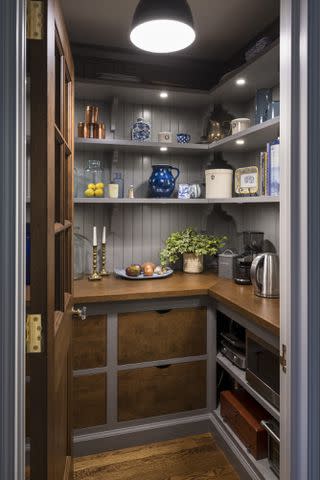Capture the Warmth of Early American Architecture with a Colonial Kitchen
Here’s how to bring home the traditional style with handmade, rustic charm.

Courtesy of Studio Dearborn
If you long for a kitchen that exudes warmth and craftsmanship, consider a Colonial-inspired kitchen. Colonial style refers to the houses of the American colonies, particularly in the 17th and 18th centuries. In these homes, kitchens were simple and hardworking. “Cooking centered around a large wood-fired hearth and a long, sturdy table often filled the center of the room,” says Kimberly Kerl, founder and principal designer at Kustom Home Design.
These spaces were not the uniformly manufactured kitchens of today, but rather more varied and unfitted in their style. “They were a menagerie of handmade tables, rough-sawn timbers, furniture bases with stone counters, hammered sinks, and stone backsplashes,” says Kerl.
Although today's kitchens are more complex, they can still capture the era’s charm. “Today’s colonial kitchens often pull from architecture, furniture, and colonial millwork influences,” says Sarah Robertson, founder and principal designer of Studio Dearborn. The result is a classic, traditional style that embraces the refined (and sometimes rustic) touches of Colonial architecture and decorating.

Ben Ivins / Courtesy of Kustom Home Design
Elements of Colonial Kitchens
Larger layouts and design elements paired with period-inspired details are the keys to bringing Colonial style home to the kitchen.
Prominent Cooking Area
The main feature of a Colonial kitchen was a stone hearth used for cooking. Today, emphasis can be placed on the range or cooking area for a similar appeal. “Large wall-mounted hoods that resemble a hearth frequently accompanied by a mantel shelf or masonry materials, such as brick, stone or stucco, allude to the eye-catching size and scale of Colonial cooking fireplaces,” says Kerl.
Central Workspace
“A central island or table is considered a defining element,” says Kerl. In addition to a large hearth, authentic Colonial kitchens generally featured a table as a workspace and a spot for in-kitchen dining. A wooden table or butcher-block island achieves a similar unfitted look that still allows the kitchen to feel (and look) open and airy. An island can offer similar, though more robust, practical features.
Mix of Storage Styles
Colonial kitchens are characterized by a more eclectic mix of storage than most kitchen design styles. Colonial style is not fully fitted with traditional cabinets, but rather pieces that Kerl says “resemble the look and feel of furniture.” Having a mix is critical to achieve the warm aesthetic.
“Key design elements include the use of cabinets with a variety of finishes, including stained and painted pieces,” says Kerl. Base cabinetry that visually varies from upper cabinets, a mix of open and closed storage, and cabinets that sit upon the counter, rather than upper wall-hung cabinets, help achieve the look. Kerl also notes that cabinet details, like latch-style hardware, copper and brass finishes, and irregularly textured or patterned glass accents have the rustic, handmade feel of a Colonial kitchen.
Natural Elements
Surfaces from floors to walls, ceilings, and countertops would have largely been a mix of stone and wood in Colonial kitchens–elements that are easy to incorporate today. Robertson recommends wide plank wood floors to capture the Colonial feel. “You can also integrate natural materials such as wood beams, accents, and exposed brick for an old-world charm,” she says. Countertops of wood or natural stone add an elevated texture and pattern. Choosing locally sourced materials, or material common to the area, is a nod to the historically local craftsmanship of the Colonial kitchen.

Courtesy of Studio Dearborn
Colonial Kitchen Design Tips
“Colonial is the perfect style for an early-American home like a Colonial revival, farmhouse, or Cape Cod style. It is a great fit for homeowners who have a traditional design sense,” says Robertson. “It is usually for those less likely to take color risks in their kitchen."
Because Colonial style is classic, rather than trend-based, its neutral color palettes help the kitchen remain timeless. “Neutral and muted colors are typically used for the main parts of the design like the cabinets,” says Robertston.
When outfitting a colonial kitchen, strive to choose period-appropriate complements. “We prefer the use of classic tile, such as subway with a watercolor glaze, or historic tiles such as Delft, which would have been used in wealthy Colonists' homes for decorative areas,” says Robertston. She also advocates for oil-rubbed bronze or mixed metals in lighting and cabinet hardware. “Style-wise you will want to go more traditional and stay away from modern, simple lines,” she says.
For more Better Homes & Gardens news, make sure to sign up for our newsletter!
Read the original article on Better Homes & Gardens.

